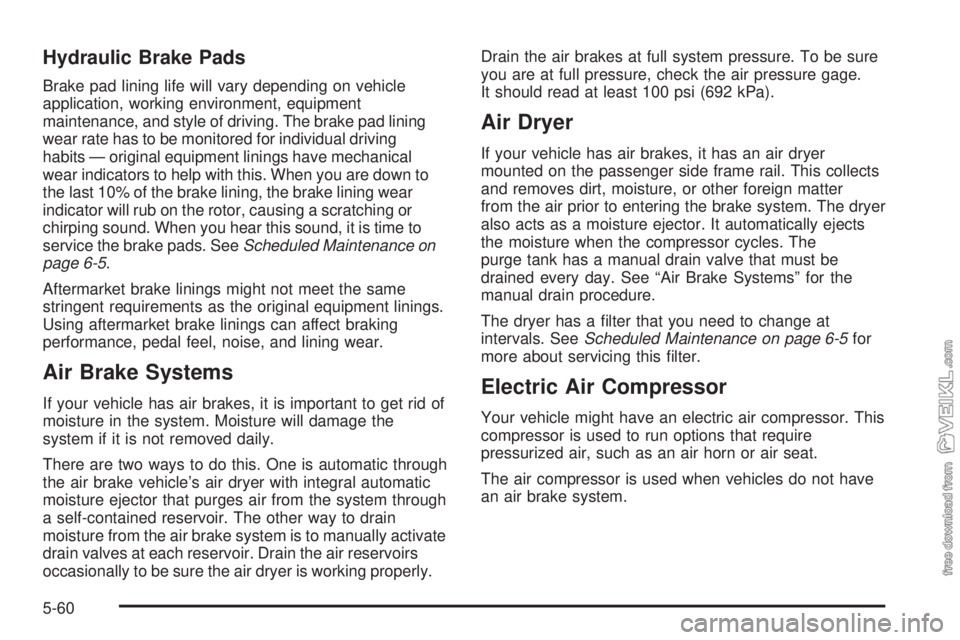brake rotor CHEVROLET KODIAK 2008 Owners Manual
[x] Cancel search | Manufacturer: CHEVROLET, Model Year: 2008, Model line: KODIAK, Model: CHEVROLET KODIAK 2008Pages: 384, PDF Size: 5.4 MB
Page 264 of 384

Hydraulic Brake Pads
Brake pad lining life will vary depending on vehicle
application, working environment, equipment
maintenance, and style of driving. The brake pad lining
wear rate has to be monitored for individual driving
habits — original equipment linings have mechanical
wear indicators to help with this. When you are down to
the last 10% of the brake lining, the brake lining wear
indicator will rub on the rotor, causing a scratching or
chirping sound. When you hear this sound, it is time to
service the brake pads. SeeScheduled Maintenance on
page 6-5.
Aftermarket brake linings might not meet the same
stringent requirements as the original equipment linings.
Using aftermarket brake linings can affect braking
performance, pedal feel, noise, and lining wear.
Air Brake Systems
If your vehicle has air brakes, it is important to get rid of
moisture in the system. Moisture will damage the
system if it is not removed daily.
There are two ways to do this. One is automatic through
the air brake vehicle’s air dryer with integral automatic
moisture ejector that purges air from the system through
a self-contained reservoir. The other way to drain
moisture from the air brake system is to manually activate
drain valves at each reservoir. Drain the air reservoirs
occasionally to be sure the air dryer is working properly.Drain the air brakes at full system pressure. To be sure
you are at full pressure, check the air pressure gage.
It should read at least 100 psi (692 kPa).
Air Dryer
If your vehicle has air brakes, it has an air dryer
mounted on the passenger side frame rail. This collects
and removes dirt, moisture, or other foreign matter
from the air prior to entering the brake system. The dryer
also acts as a moisture ejector. It automatically ejects
the moisture when the compressor cycles. The
purge tank has a manual drain valve that must be
drained every day. See “Air Brake Systems” for the
manual drain procedure.
The dryer has a filter that you need to change at
intervals. SeeScheduled Maintenance on page 6-5for
more about servicing this filter.
Electric Air Compressor
Your vehicle might have an electric air compressor. This
compressor is used to run options that require
pressurized air, such as an air horn or air seat.
The air compressor is used when vehicles do not have
an air brake system.
5-60
Page 344 of 384

300,000 Miles (480 000 km)
❑Rear axle service — Eaton®, Rockwell®, Spicer®
axles (or every 12 months, whichever occurs
first).(30)
❑Remove, disassemble, clean, and inspect the air
brake air dryer (or every 3 years, or 10,800 hours,
whichever occurs first). Replace desiccant.
❑Isuzu Diesel Only: Diesel Particulate Filter (DPF)
service (or every 4,500 hours, whichever occurs
first). Then every 150,000 miles (240 000 km),
or every 4,500 hours, whichever occurs first.(7)
Footnotes
† = The U.S. Environmental Protection Agency or the
California Air Resources Board has determined that the
failure to perform this maintenance item will not nullify
the emission warranty or limit recall liability prior to the
completion of the vehicle’s useful life. We, however, urge
that all recommended maintenance services be
performed at the indicated intervals and the maintenance
be recorded.
(1)= If your vehicle has an Allison Transmission
®, your
owner manual is supplemented by an Allison
Transmission
®Operator’s Manual. Always refer to these
manuals for related maintenance services.
(2)= An Emission Control Service.
(3)= A Noise Emission Control Device.(4)= Applies to vehicles sold in the United States and is
recommended for vehicles sold in Canada.
(5)= Check fluid level in brake master cylinder, power
steering pump, front and rear axles, transmission, and
hydraulic spring parking brake pump (if equipped). A low
fluid level in the brake master cylinder can indicate worn
brake linings and should be checked accordingly.
(6)= Inspect brake lines and hoses for proper hook-up,
binding, leaks, cracks, chafing, etc. Inspect disc brake
pads for wear and rotors for surface condition. Inspect
caliper assemblies. Check brake pedal for excessive free
play or travel (or every 6 months, whichever occurs first)
and have serviced if needed. Check brakes more often if
driving habits and conditions result in frequent braking.
(7)= Check for filter ash, sensor adjustment, and sensor
hose restriction. Clean as needed. This service can be
complex; you should have your dealer/retailer perform
this service.
(8)= This vehicle has the Engine Oil Life System. This
system will show you when to change the engine oil
and filter — usually between 3,000 miles (5 000 km) and
7,500 miles (12 000 km) since your last oil change.
Under severe conditions, the indicator may come
on before 3,000 miles (5 000 km). Never drive your
gasoline engine vehicle more than 7,500 miles
(12 000 km) or 12 months without an oil and filter
change.
6-20